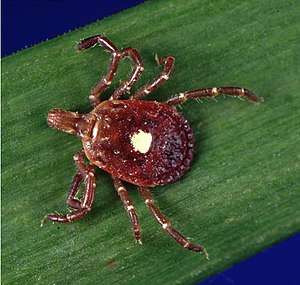Hyalomma brevipunctata
The Sharif's Indian Hyalomma, (Hyalomma brevipunctata), is a hard-bodied tick of the genus Hyalomma. It is found in India and Sri Lanka.[1]
| Hyalomma brevipunctata | |
|---|---|
| Scientific classification | |
| Kingdom: | |
| Phylum: | |
| Class: | |
| Order: | |
| Family: | |
| Subfamily: | Hyalomminae |
| Genus: | |
| Species: | H. brevipunctata |
| Binomial name | |
| Hyalomma brevipunctata Sharif, 1928 | |
| Synonyms | |
| |
Parasitism
It is an obligate ectoparasite of mammals such as cattle, goats, buffaloes, dogs, camels. Rare specimens were collected from humans, blue bull, sambar, and spotted deer.[2] It is a potential vector of Kyasanur Forest disease virus.[3]
Description
Male has comma-shaped spiracular plates. Female has an elongate, oval operculum.
gollark: *But* with 3D-printing and stuff, that's reducing slightly, and that could conceivably be extended more to produce most stuff we're used to from a bunch of sand or something via nanofabrication.
gollark: But anyway, currently basically all our technology is tied together in the giant worldwide infrastructure whatsit, and becoming more so.
gollark: ASCII diagramming is hard.
gollark: I think the amount of stuff you need to produce what we'd consider "basic needs" will make a sort of uppy-downy curve over time.``` __/ \_```
gollark: Which they can't particularly do if some other company says "we have an excess, you can just take these".
References
- "Species Details : Hyalomma brevipunctata Sharif, 1928". Catalogue of Life. Retrieved 11 February 2017.
- "THE HY ALOM.lviA TICKS (IXODOIDEA, IXODIDAE) OF PAKISTAN, INDIA, AND CEYLON, WITH KEYS TO SUBGENERA AND SPECIES". Acarologia. Retrieved 11 February 2017.
- Singh, KR; Pavri, KM; Anderson, CR (1964). "Transmission of Kyasanur Forest Disease Virus by Haemaphysalis Turturis, Haemaphysalis Papuana Kinneari and Haemaphysalis Minuta". Indian Journal of Medical Research. 52: 566–73. PMID 14184087.
External links
This article is issued from Wikipedia. The text is licensed under Creative Commons - Attribution - Sharealike. Additional terms may apply for the media files.
